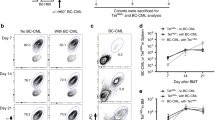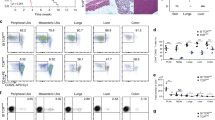Abstract
Despite the ease of inhibiting immune responses by blockade of T-cell costimulation in naive rodent models, it is difficult to suppress those responses in animals with memory cells1,2. Studies demonstrating the importance of alloreactive T-cell deletion during tolerance induction have promoted use of peritransplant T-cell-depleting therapies in clinical trials3,4,5,6. But potentially complicating wide-scale, nonspecific T-cell depletion is the finding that extensive T-cell proliferation can occur under conditions of lymphopenia. This process, termed homeostatic proliferation7,8, may induce acquisition of functional memory T cells9,10,11,12,13. Here, using clinically relevant mouse models of peripheral T-cell depletion, we show that residual nondepleted T cells undergo substantial homeostatic expansion. In this setting, costimulatory blockade neither significantly suppresses homeostatic proliferation nor prevents allograft rejection. In addition, T cells that have completed homeostatic proliferation show dominant resistance to tolerance when adoptively transferred into wild-type recipients, consistent with known properties of memory cells in vivo. These findings establish the importance of homeostatic proliferation in clinically relevant settings, demonstrate the barrier that homeostatic proliferation can present to the induction of transplantation tolerance, and have important implications for transplantation protocols that use partial or complete peripheral T-cell depletion.
This is a preview of subscription content, access via your institution
Access options
Subscribe to this journal
Receive 12 print issues and online access
$209.00 per year
only $17.42 per issue
Buy this article
- Purchase on Springer Link
- Instant access to full article PDF
Prices may be subject to local taxes which are calculated during checkout




Similar content being viewed by others
References
Valujskikh, A., Pantenburg, B. & Heeger, P.S. Primed allospecific T cells prevent the effects of costimulatory blockade on prolonged cardiac allograft survival in mice. Am. J. Transpl. 2, 501–509 (2002).
Onodera, K. et al. CD28-B7 T cell costimulatory blockade by CTLA4Ig in sensitized rat recipients: induction of transplantation tolerance in association with depressed cell-mediated and humoral immune responses. J. Immunol. 159, 1711–1717 (1997).
Li, Y. et al. Blocking both signal 1 and signal 2 of T-cell activation prevents apoptosis of alloreactive T cells and induction of peripheral allograft tolerance. Nat. Med. 5, 1298–1302 (1999).
Wells, A.D. et al. Requirement for T-cell apoptosis in the induction of peripheral transplantation tolerance. Nat. Med. 5, 1303–1307 (1999).
Kirk, A.D. et al. Results from a human tolerance trial using CAMPATH-1H with and without infliximab. Am. J. Transpl. 2 (suppl. 3), 379 (2002).
Knechtle, S.J. et al. CAMPATH-1H induction plus rapamycin monotherapy in renal transplantation. Am. J. Transpl. 2 (suppl. 3), 459 (2002).
Ernst, B., Lee, D.S., Chang, J.M., Sprent, J. & Surh, C.D. The peptide ligands mediating positive selection in the thymus control T cell survival and homeostatic proliferation in the periphery. Immunity 11, 173–181 (1999).
Goldrath, A.W. & Bevan, M.J. Low-affinity ligands for the TCR drive proliferation of mature CD8+ T cells in lymphopenic hosts. Immunity 11, 183–190 (1999).
Kieper, W.C. & Jameson, S.C. Homeostatic expansion and phenotypic conversion of naive T cells in response to self peptide/MHC ligands. Proc. Natl. Acad. Sci. USA 96, 13306–13311 (1999).
Murali-Krishna, K. & Ahmed, R. Cutting edge: naive T cells masquerading as memory cells. J. Immunol. 165, 1733–1737 (2000).
Goldrath, A.W., Bogatzki, L.Y. & Bevan, M.J. Naive T cells transiently acquire a memory-like phenotype during homeostasis-driven proliferation. J. Exp. Med. 192, 557–564 (2000).
Prlic, M., Blazar, B.R., Khoruts, A., Zell, T. & Jameson, S.C. Homeostatic expansion occurs independently of costimulatory signals. J. Immunol. 167, 5664–5668 (2001).
Gudmundsdottir, H. & Turka, L.A. A closer look at homeostatic proliferation of CD4+ T cells: costimulatory requirements and role in memory formation. J. Immunol. 167, 3699–3707 (2001).
Sharabi, Y. & Sachs, D.H. Mixed chimerism and permanent specific transplantation tolerance induced by a nonlethal preparativew regimen. J. Exp. Med. 169, 493–502 (1989).
Sayegh, M., Zheng, X.-G., Magee, C., Hancock, W. & Turka, L. Donor antigen is necessary for the prevention of chronic rejection in CTLA4Ig-treated murine cardiac allografts. Transplantation 64, 1646–1650 (1997).
Larsen, C.P. et al. Long-term acceptance of skin and cardiac allografts after blocking CD40 and CD28 pathways. Nature 381, 434–438 (1996).
Gavin, M.A., Clarke, S.R., Negrou, E., Gallegos, A. & Rudensky, A. Homeostasis and anergy of CD4+CD25+ suppressor T cells in vivo. Nat. Immunol. 3, 33–41 (2002).
Chalasani, G., Dai, Z., Konieczny, B.T., Baddoura, F.K. & Lakkis, F.G. Recall and propagation of allospecific memory T cells independent of secondary lymphoid organs. Proc. Natl. Acad. Sci. USA 99, 6175–6180 (2002).
Adams, A.B. et al. Heterologous immunity provides a potent barrier to transplantation tolerance. J. Clin. Invest. 111, 1887–1895 (2003).
Barthlott, T., Kassiotis, G. & Stockinger, B. T cell regulation as a side effect of homeostasis and competition. J. Exp. Med. 197, 451–460 (2003).
Suchin, E., Wells, A.D. & Turka, L.A. Quantifying the frequency of alloreactive cells in vivo: new answers to and old question. J. Immunol. 166, 973–981 (2001).
Sykes, M. Mixed chimerism and transplant tolerance. Immunity 14, 417–424 (2001).
Spitzer, T.R. et al. Combined histocompatibility leukocyte antigen-matched donor bone marrow and renal transplantation for multiple myeloma with end stage renal disease: the induction of allograft tolerance through mixed lymphohematopoietic chimerism. Transplantation 68, 480–484 (1999).
Buhler, L.H. et al. Induction of kidney allograft tolerance after transient lymphohematopoietic chimerism in patients with multiple myeloma and end-stage renal disease. Transplantation 74, 1405–1409 (2002).
Kawai, T. et al. Mixed allogeneic chimerism and renal allograft tolerance in cynomolgus monkeys. Transplantation 59, 256–262 (1995).
Hu, H.M., Poehlein, C.H., Urba, W.J. & Fox, B.A. Development of antitumor immune responses in reconstituted lymphopenic hosts. Cancer Res. 62, 3914–3919 (2002).
Dummer, W. et al. T cell homeostatic proliferation elicits effective antitumor autoimmunity. J. Clin. Invest. 110, 185–192 (2002).
Hakim, F.T. et al. Constraints on CD4 recovery postchemotherapy in adults: thymic insufficiency and apoptotic decline of expanded peripheral CD4 cells. Blood 90, 3789–3798 (1997).
Wells, A.D., Gudmundsdottir, H. & Turka, L.A. Following the fate of individual T cells throughout activation and clonal expansion. Signals from T cell receptor and CD28 differentially regulate the induction and duration of a proliferative response. J. Clin. Invest. 100, 3173–3183 (1997).
Hancock, W.W. et al. Costimulatory function and expression of CD40-ligand, CD80, and CD86 in vascularized murine cardiac allograft rejection. Proc. Natl. Acad. Sci. USA 93, 13967–13972 (1996).
Acknowledgements
We thank T. Laufer, F. Lakkis, T. Strom, M. Sykes, D. Sachs, H. Petrie and J. Bluestone for helpful discussions; A. Wells for critical review of the manuscript; and T. Gray for expert animal care. This work was supported by National Institutes of Health grants AI-37691 (L.A.T.), AI-41521 (M.H.S. and L.A.T.) and AI-43626 (L.A.T.).
Author information
Authors and Affiliations
Corresponding author
Ethics declarations
Competing interests
The authors declare no competing financial interests.
Rights and permissions
About this article
Cite this article
Wu, Z., Bensinger, S., Zhang, J. et al. Homeostatic proliferation is a barrier to transplantation tolerance. Nat Med 10, 87–92 (2004). https://doi.org/10.1038/nm965
Received:
Accepted:
Published:
Issue Date:
DOI: https://doi.org/10.1038/nm965
This article is cited by
-
Homeostatic proliferation leads to telomere attrition and increased PD-1 expression after autologous hematopoietic SCT for systemic sclerosis
Bone Marrow Transplantation (2018)
-
Solid Organ Transplantation for HIV-Infected Individuals
Current Treatment Options in Infectious Diseases (2018)
-
Graft-infiltrating host dendritic cells play a key role in organ transplant rejection
Nature Communications (2016)
-
Memory T cells in organ transplantation: progress and challenges
Nature Reviews Nephrology (2016)
-
A septin requirement differentiates autonomous and contact-facilitated T cell proliferation
Nature Immunology (2016)



